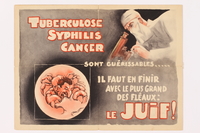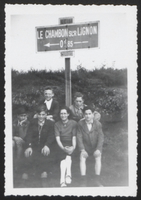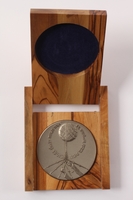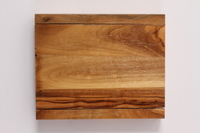Overview
- Brief Narrative
- Document case for a certificate (.2a) awarded posthumously to Juliette Usach in recognition as a “Righteous Among the Nations,” by Yad Vashem in Jerusalem, Israel. Yad Vashem confers the honor on those who risked their lives to save Jews during the Holocaust. Juliette Usach was a Protestant, Spanish doctor who fled to France in 1938 as a refugee of the Spanish Civil War. In 1939, she moved to the village of Chambon-sur-Lignon to become the director of a boarding house for Spanish mothers and children. After Germany’s invasion of France in May 1940, antisemitic legislation led to Jews being imprisoned in internment camps. Chambon became a haven for refugees, and the entire town worked together to create a welcoming and safe environment. With assistance from numerous organizations, Chambon’s pastor, André Trocmé, arranged the release of many Jewish children from the camps. Juliette’s house was refurbished, and on May 14, 1941, reopened as “La Guespy,” the first of what would become several children’s homes in Chambon. While at La Guespy, children resumed schooling and were encouraged to attend religious services. Juliette consciously cultivated an atmosphere of religious tolerance and encouraged collective participation in both Jewish and non-Jewish holidays. Following the liberation of France in September 1944, Juliette remained in Chambon until 1964, when she moved to Lyon to join the Salvation Army.
- Date
-
issue:
1989 April 18-1990 September 10
commemoration: 1941-1944
- Geography
-
issue:
Jerusalem, Israel
- Credit Line
- United States Holocaust Memorial Museum Collection, Gift of Rudy Appel
- Markings
- top, center, impressed, gold paint, within emblem: [Hebrew characters] [Israel]
bottom, center, impressed, gold paint : [Hebrew characters] / YAD VASHEM / The Holocaust Martyrs’ and Heroes’ / Remembrance Authority / Jerusalem - Contributor
-
Subject:
Juliette Usach
Issuer: Yad Vashem
- Biography
-
Juliette Usach (1899-1984) was born in Spain to a Protestant pastor. After completing school, Juliette became a doctor. On July 17, 1936, Nationalist rebels staged an uprising against the Spanish democratically-elected republic, beginning the Spanish Civil War. Both Nazi Germany and Fascist Italy intervened on behalf of the Nationalists. The conflict led to mass violence, and a large number of loyalists were imprisoned in concentration camps or conscripted for forced labor. In 1938, Juliette fled to Pau, about 31 miles over the border in France. In 1939, Juliette was recruited by Marguerite de Felice, a member of the International Relief for Women and Children of the Spanish Republic, to manage a boarding house for Spanish mothers and children. That May, Juliette, her father, and her sister moved to Chambon-sur-Lignon, a Protestant village in south-central France, where the boarding house was located.
On September 3, two days after Germany invaded Poland, France declared war on Germany. In May 1940, Germany invaded France and forced their surrender in June. Germany occupied Northern France and the Atlantic coastline while the southern and eastern regions, including Chambon, were administered the new Vichy French government. The Vichy regime collaborated with the Nazis; instituting antisemitic legislation and camps patterned after those in Germany. That winter, Chambon’s pastor, André Trocmé and a contact with the American Friends Service Committee arranged the release of many Jewish children from the French internment camps. They were then taken in by the residents of Chambon and other villages in the region. Pastor Trocmé received assistance from le Comité Inter-Mouvements Auprès des Évacués (CIMAD, the Inter-Movement Committee for Evacuees) and the Secours Suisse aux Enfants (Swiss Society for Children’s Aid) to establish a colony for refugee children in Chambon.
As part of this effort, in 1941, Juliette’s house was converted into a refuge for Jewish children. The refurbished house officially opened on May 14, 1941 as “La Guespy,” and housed children released from the internment camps, between ages 14 and 18. The group was comprised of adolescents from various European countries, and a mix of Jews, Catholics, and Protestants. Juliette was assisted by two supervisors, a cook, a housekeeper, and a teacher. While at La Guespy, children resumed schooling and were encouraged to attend religious services. Juliette consciously cultivated an atmosphere of religious tolerance and encouraged collective participation in both Jewish and non-Jewish holidays. The success of Guespy led to the opening of a second house for children in November. La Guespy was one of several children’s homes in the village under the direction of August Bohny, a Swiss school teacher and representative of the Swiss Red Cross. Collectively, the village housed around 200 refugee children.
In the summer of 1942, the Vichy government began allowing round ups of Jews. On August 25, Juliette was away from Guespy and her wards were sent to another protective house. A group of policemen attempted a raid on the house and were confronted by August Bohny, who claimed the children were under the protection of the Swiss government. He threatened diplomatic action, and the gendarmes backed down. In November, Germany occupied the remainder of “free” France. By the end of December, Guespy housed 23 children. In 1943, the average age of the Guespy residents decreased to 13 or 14, mostly boys, who required more attention from the caretakers. Regular raids continued to occur in Chambon, however, Juliette and the residents of the community were able to protect the children. Though the children remained unharmed, the number of refugees the town could safeguard decreased.
On June 6, 1944, the Allies landed in Normandy, beginning the liberation of France. The region surrounding Chambon was liberated by the Free French First Armored Division on September 2-3. Following the war, Juliette remained in Chambon. She ran a bookstore there from 1950 to 1964, and then joined the Salvation Army in Lyon. She lived her last years at the Rollin Foundation, a Protestant retirement home. On April 18, 1989, in recognition of her efforts at La Guespy, Yad Vashem recognized Juliette Usach as Righteous Among the Nations.
Physical Details
- Classification
-
Containers
- Category
-
Cases
- Object Type
-
Document containers (aat)
- Genre/Form
- Certificates.
- Physical Description
- Rectangular, bifold document holder with Hebrew and English text and emblems in gold on the front, designed to hold a certificate (.2a). The covers are formed from cardboard panels covered with faux, textured brown leather and a thin layer of padding. The corner of each cover is rounded, and there are short, raised lines along the outer edges, which mimic stitching. The curved spine is along the right edge of the holder in order to align properly with the Hebrew text. Both emblems and the seven lines of text, three in Hebrew followed by four in English, are centered on the cover, pressed into the surface, and filled with faux gold leaf, likely gold paint. At the top is the shield-shaped Emblem of Israel, a seven-branched menorah flanked by a vertical length of olive branch on each side and above the word Israel in Hebrew characters. At the center is the emblem of Yad Vashem, a stylized, six-branched menorah above a curving line, and at the bottom are the lines of Hebrew and English text. The interior surfaces are smooth and flat, each containing a clear, full-sized, clear plastic pocket sealed along the top, bottom, and outer edge. The inner edges are open to allow a document to be slid beneath the edge and into the clear, protective pocket.
- Dimensions
- overall: Height: 14.000 inches (35.56 cm) | Width: 10.250 inches (26.035 cm) | Depth: 0.250 inches (0.635 cm)
- Materials
- overall : plastic, paint, cardboard
Rights & Restrictions
- Conditions on Access
- No restrictions on access
- Conditions on Use
- No restrictions on use
Keywords & Subjects
- Topical Term
- Altruism. Child concentration camp inmates--Care. Hidden children (Holocaust)--France. Judaism--Relations--Christianity. Protestants--France. Righteous Gentiles in the Holocaust--France. World War, 1939-1945--Occupied territories. Refugee assistance groups (ushmm)
- Geographic Name
- Jerusalem. Le Chambon-sur-Lignon (France) Pau (France) Spain. France.
Administrative Notes
- Legal Status
- Permanent Collection
- Provenance
- The document case was donated to the United States Holocaust Memorial Museum in 1992 by Rudy Appel, a ward of Juliette Usach.
- Record last modified:
- 2023-08-23 15:34:48
- This page:
- https://collections.ushmm.org/search/catalog/irn7090
Also in Rudy Appel collection
The collection consists of a medal, certificate, poster, photographs, and correspondence relating to the experiences of Rudy Appel, his parents, Julius and Rose Appel, and caretaker, Juliette Usach, in Germany, the Netherlands, Belgium, and France before, during, and after the Holocaust.
Date: 1939-1990

Antisemitic flyer acquired by a French Jewish child in hiding
Object
Antisemitic propaganda flyer found pinned to a wall and acquired by Rudy Appel in wartime France. The image depicts a louse-like caricature of a Jew and compares Jews to well-known diseases. This message draws upon centuries-old antisemitic stereotypes of Jews as dirty and vectors of disease. Pejoratives such as “dirty Jew” and antisemitic myths such as a Jewish odor caused by bad hygiene or a poor diet were common during the 19th century. Rudy was living with his parents and brother in Mannheim, Germany, when Adolf Hitler and the Nazis came to power in January 1933. Following the Kristallnacht pogroms in November 1938, Rudy’s father Julius was imprisoned in Dachau concentration camp, and his brother, Martin, immigrated to the United States. Julius followed when he was released from Dachau in January 1939. Rudy was sent to a school in Rotterdam, Netherlands, while his mother, Rose, fled to Belgium. When Germany invaded western Europe in May 1940, Rudy joined his mother in Belgium. The pair attempted to escape to unoccupied southern France, but were arrested near Angouleme and sent to Rivesaltes internment camp. In September 1942, Rudi was among a group of children escorted by Friedel Reiter (later Bohny-Reiter) to Le Chambon sur Lignon, a Protestant village in southern France. He was placed in La Guespy, a children’s home in the town operated by Secours Suisse aux Enfants (Swiss Society for Children’s Aid). Rudy was able to resume schooling and lived in relative safety due to the entire town’s dedication to helping refugees. The region surrounding Chambon was liberated by the Free French First Armored Division on September 2-3. After the war, Rudy reunited with his mother and in November 1946, they immigrated to the United States.

Rudy Appel papers
Document
The Rudy Appel papers include Red Cross form correspondence among Rudy Appel, his mother in Gurs, and his father in Philadelphia as well as photographs of the La Guespy children's home run by Secours Suisse aux enfants where Appel was sheltered during the war, the home's director Juliette Usach, and other children who stayed at the home.

Righteous Among the Nations medal awarded to a French children’s home director
Object
Medal awarded posthumously to Juliette Usach in recognition as a “Righteous Among the Nations,” by Yad Vashem in Jerusalem, Israel. Yad Vashem confers the honor on those who risked their lives to save Jews during the Holocaust. Juliette Usach was a Protestant, Spanish doctor who fled to France in 1938 as a refugee of the Spanish Civil War. In 1939, she moved to the village of Chambon-sur-Lignon to become the director of a boarding house for Spanish mothers and children. After Germany’s invasion of France in May 1940, antisemitic legislation led to Jews being imprisoned in internment camps. Chambon became a haven for refugees, and the entire town worked together to create a welcoming and safe environment. With assistance from numerous organizations, Chambon’s pastor, André Trocmé, arranged the release of many Jewish children from the camps. Juliette’s house was refurbished, and on May 14, 1941, reopened as “La Guespy,” the first of what would become several children’s homes in Chambon. While at La Guespy, children resumed schooling and were encouraged to attend religious services. Juliette consciously cultivated an atmosphere of religious tolerance and encouraged collective participation in both Jewish and non-Jewish holidays. Following the liberation of France in September 1944, Juliette remained in Chambon until 1964, when she moved to Lyon to join the Salvation Army.

Presentation box for medal awarded to a French children’s home director
Object
Presentation box for medal awarded posthumously to Juliette Usach in recognition as a “Righteous Among the Nations,” by Yad Vashem in Jerusalem, Israel. Yad Vashem confers the honor on those who risked their lives to save Jews during the Holocaust. Juliette Usach was a Protestant, Spanish doctor who fled to France in 1938 as a refugee of the Spanish Civil War. In 1939, she moved to the village of Chambon-sur-Lignon to become the director of a boarding house for Spanish mothers and children. After Germany’s invasion of France in May 1940, antisemitic legislation led to Jews being imprisoned in internment camps. Chambon became a haven for refugees, and the entire town worked together to create a welcoming and safe environment. With assistance from numerous organizations, Chambon’s pastor, André Trocmé, arranged the release of many Jewish children from the camps. Juliette’s house was refurbished, and on May 14, 1941, reopened as “La Guespy,” the first of what would become several children’s homes in Chambon. While at La Guespy, children resumed schooling and were encouraged to attend religious services. Juliette consciously cultivated an atmosphere of religious tolerance and encouraged collective participation in both Jewish and non-Jewish holidays. Following the liberation of France in September 1944, Juliette remained in Chambon until 1964, when she moved to Lyon to join the Salvation Army.
Honorary certificate issued to Juliette Usach by Yad Vashem
Object
Certificate awarded posthumously to Juliette Usach in recognition as a “Righteous Among the Nations,” by Yad Vashem in Jerusalem, Israel. Yad Vashem confers the honor on those who risked their lives to save Jews during the Holocaust. Juliette Usach was a Protestant, Spanish doctor who fled to France in 1938 as a refugee of the Spanish Civil War. In 1939, she moved to the village of Chambon-sur-Lignon to become the director of a boarding house for Spanish mothers and children. After Germany’s invasion of France in May 1940, antisemitic legislation led to Jews being imprisoned in internment camps. Chambon became a haven for refugees, and the entire town worked together to create a welcoming and safe environment. With assistance from numerous organizations, Chambon’s pastor, André Trocmé, arranged the release of many Jewish children from the camps. Juliette’s house was refurbished, and on May 14, 1941, reopened as “La Guespy,” the first of what would become several children’s homes in Chambon. While at La Guespy, children resumed schooling and were encouraged to attend religious services. Juliette consciously cultivated an atmosphere of religious tolerance and encouraged collective participation in both Jewish and non-Jewish holidays. Following the liberation of France in September 1944, Juliette remained in Chambon until 1964, when she moved to Lyon to join the Salvation Army.



